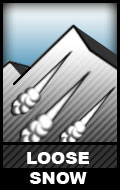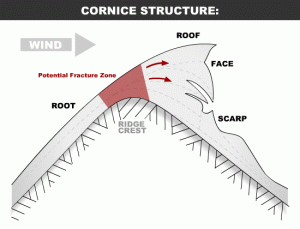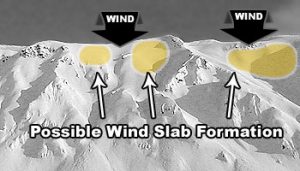Avalanche Danger Forecast
Issued Monday, February 22, 2021 at 10:15am for the greater Anchorage area Western Chugach Mountains (i.e. Chugach State Park). View map of primary forecast area here.
Avalanche danger will increase Monday and Tuesday, but is expected to remain within the moderate spectrum. A couple inches of new snow from Sunday night into Monday morning will be wind loaded by moderate to strong winds: primarily from the NW Monday and the SE Tuesday. Expect fresh wind slabs on upper elevation leeward terrain to be reactive to human triggers.
Avalanche danger is expected to increase further on Wednesday and may reach considerable. More snow is expected for the region late Tuesday into Wednesday (a few to several inches is possible in the alpine). While the amount of new snow itself isn’t expected to significantly increase avalanche danger, moderate to strong winds accompanying and following the new snow will wind load leeward terrain making natural avalanches possible and human triggered avalanches likely.
Danger is expected to decrease Thursday as winds are forecast to decline and no significant new snow is expected during the day. However, if new snow materializes or winds are stronger than currently forecast expect the danger to increase accordingly.
Mountain Weather:
Monday: decreasing clouds, light to moderate west to north wind (possibly strong in more exposed upper elevation areas), alpine temps in the single digits to teens
Tuesday: increasing clouds with a chance of snow later, moderate to strong east to south wind, alpine temps warming into the 20s
Wednesday: cloudy with a chance of snow, moderate to strong east to south wind, alpine temps in the 20s
Thursday: cloudy with a chance of snow, light to moderate wind, alpine temps in the 20s
Discussion:
Last week the mountains received a couple inches of new snow Tuesday and another couple inches Thursday. Both snow events produced very light and low density snow that did not bond well and was easily swept away by increasing winds that followed the snowfalls. Neither snow event provided enough accumulation to significantly improve riding conditions.
Temperatures and winds increased significantly between last Tuesday and Thursday’s snowfall and early Wednesday the upper elevations received a trickle of relatively high water content snow. Temperatures warmed further later Wednesday and sunshine in the afternoon warmed and saturated near surface snow. As temperatures since have remained much colder and solar radiation hasn’t been as intense, a ~3cm melt-freeze crust (supportable in places, breakable in others) now exists on solar aspects at the mid elevations in some areas. On Sunday, recently formed wind slabs were reactive to human triggers where they had formed on top of this melt-freeze crust.
Wednesday’s warmup and melt-freeze of the upper few centimeters of the snowpack did a lot to improve the temperature gradient in regard to bonding and stabilization of buried persistent weak layers, especially near surface facets that developed from cold weather earlier this month and can generally be found buried within the upper half of the snowpack (where they were not wind-packed into dense, rounded layers).
This week, widespread snowfall is expected late Tuesday into Wednesday and there’s the possibility of further accumulation later in the week. While snow events this week may produce several inches of accumulation in the alpine, it will be winds that accompany or follow any snow events that significantly increase avalanche danger.
Avalanche Problems:
 Wind slabs up to D2 in size above 2500′ on leeward terrain steeper than 35º.
Wind slabs up to D2 in size above 2500′ on leeward terrain steeper than 35º.
Shifting winds this forecast period (primarily from the west to north Monday and east to south Tuesday-Wednesday) will load leeward terrain.
Active wind loading, recent avalanches, and shooting cracks are red flag indicators of wind slab danger. Wind slabs are most likely to exist below corniced areas and along the lee sides of ridges and cross-loaded features like gullies:
Relatively densely-packed (firm and “punchier” feeling) snow and pockets of deeper snow (especially with a bulbous or fat appearance) are indicators of wind slabs. If you look closely at the snow surface you may be able to distinguish where wind slabs exist due to the snow having a more textured, densely-packed, consolidated, cohesive, and/or striated appearance. Be especially wary of (and avoid) steep, convex, and/or unsupported wind loaded terrain features.
Pole probing and hand pits are a quick and effective means of assessing this problem as you travel. Use pole probing to quickly feel out areas of denser, wind-packed snow overlying looser and weaker snow. Use hand pits to quickly assess how near-surface layers of snow are bonded.
Digging a snowpit and conducting a compression test and/or extended column test will provide an even better assessment of bonding and instability before you travel on terrain of consequence.
You can also assess wind slab instability via safer “test slopes” that are representative of higher consequence terrain.
Persistent slabs up to D2.5 in size above 2500′ on terrain steeper than 35º.
While persistent slabs may exist on all aspects, expect the problem to be the most pronounced on recently wind loaded terrain (where buried persistent weak layers may be “stressed” and haven’t adjusted to the recently added load) and shadier and colder northerly aspects (where the temperature gradient hasn’t facilitated bonding and stabilization of buried persistent weak layers).
The persistent slab problem is lower probability, but potentially much higher consequence, than the wind slab problem. Persistent slabs triggered this forecast period may be hard slabs that break deeper down in the snowpack and release above and around a human trigger (rather than at the trigger’s feet) which can make escape difficult. Hard slab avalanche debris is also more likely to cause trauma than debris from soft slabs.
Be on the lookout for red flag warnings of persistent slab danger: recent avalanches, collapsing (aka “whumphing“), and shooting cracks.
Diverse and widespread persistent weak layers exist in the snowpack. Faceted snow exists above and below crusts in some areas, sandwiched between wind packed layers in many areas, and a basal weak layer of advanced facets and depth hoar is widespread. Surface hoar may also exist in isolated areas, although dangerous terrain where it’s been buried intact is likely very limited. That said, keep it in mind if you’re traveling around mid elevation terrain traps.
 Dry loose snow avalanches (human triggered sluffing and naturally triggered spindrift) are possible above 3000′ on steep terrain (38º+) across all aspects.
Dry loose snow avalanches (human triggered sluffing and naturally triggered spindrift) are possible above 3000′ on steep terrain (38º+) across all aspects.
While these relatively small avalanches (D1) aren’t much of a concern in regard to burial, they do have the potential to cause a fall or loss of control. While not likely, it’s possible that a loose snow avalanche could trigger a larger wind or persistent slab as it descends a slope.
Don’t let a loose snow avalanche catch you off guard. Manage your sluff if descending via ski or snowboard steep and wind-sheltered terrain with loose and uncohesive snow. If it’s windy and you’re climbing steep and/or exposed terrain, be mindful of the potential for heavy spindrift that could knock you off your feet and take you for a (potentially deadly) ride.
Both natural and human triggered cornice falls are possible. Cornices are large and overhanging in some areas above 3000′. New snow and strong winds this week will make them more prone to failure and falling.
Give cornices a wide berth and don’t approach the edge of a ridge to look down slope unless you’re sure it’s not corniced. Cornices can break off further back than expected (even beyond the true edge of the mountain ridge beneath the snow surface). In addition to the danger of taking a nasty fall due to a collapsing cornice, a falling cornice may “bomb” the slope it lands on and trigger an avalanche.
Terrain management is always the best way to deal with avalanche problems: eliminate or reduce your exposure to terrain capable of producing an avalanche. Before traveling on or under terrain that has the potential to avalanche think about the consequences and have a plan (to escape the avalanche, for re-grouping, and rescue).
Always be mindful of terrain traps that can make even a small avalanche deadly.
Click the hyperlinks and icons to learn more.
Please let us know what you’re seeing by tagging us on Instagram @anchorage_avalanche_center, submitting an observation, sending an email to info@anchorageavalanchecenter.org, or via FaceBook message. All observations help us provide a better forecast product (no matter how basic). We can keep your observation confidential, and only use the information to inform forecast products.





